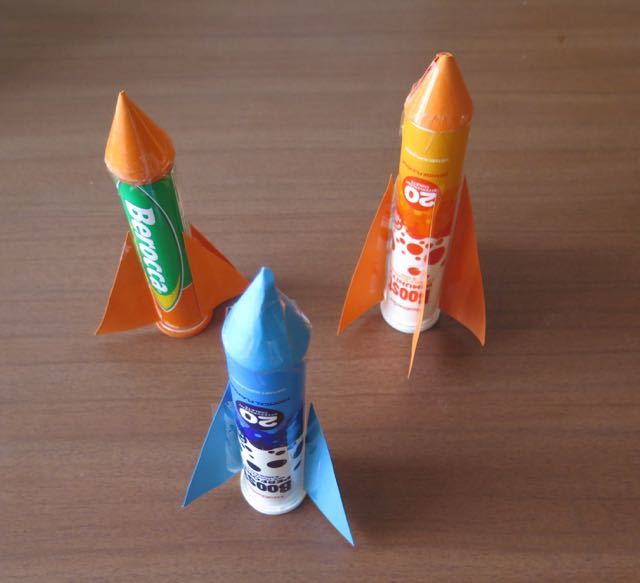Rocket science includes ideas of forces and motion, how rockets work and some of the challenges for those wanting to make rockets go faster and higher.
In the last 60 years, rocket science and technology has certainly reached new heights. Many rockets have been used to explore our atmosphere and to travel further from the Earth to explore the Moon, Venus, Mars and other parts of the Solar System and beyond. Other rockets are used to launch the many satellites that we rely on for weather forecasting and communication. Rockets are also used for fireworks and entertainment.
Rocket science and design challenges
The science of forces and motion began to be properly understood when Sir Isaac Newton wrote a book called Principia over 200 years ago. This contained his three laws of motion and paved the way for people to understand how rockets work. Before this time, a lot of people thought rockets needed air to push against. It turns out they don’t! Rockets work even better in the vacuum of space than they do in the Earth’s atmosphere.
Rocket design is all about finding an optimal balance between thrust, mass and aerodynamics. Any change to one of these will affect the overall motion of the rocket:
- For an object to start moving, there needs to be an unbalanced force. Find out more in the article Lift-off.
- Thrust is the force that pushes a rocket. There are many types of rocket engines that use different propellants. Find out more in the article Rockets and thrust.
- A rocket has mass as rocket body, payload and propellant, but with each extra bit of mass, there is extra weight that requires extra thrust.
- Aerodynamics is the study of how air flows over a rocket. Aerodynamics only affects a rocket while it is in an atmosphere. Find out how a nose cone and fins help a rocket in the article Rocket aerodynamics.
- Rockets are launched to achieve different types of orbits. Find out why in Getting rockets into space.
Meet our rocket scientists and engineers
Our rockets content looks at some of the science and related technology issues that are being solved by three different groups working on rockets and space technology.
Peter Beck is CEO and technical director of Rocket Lab, the company behind New Zealand’s first attempt at commercial space flight in 2009. In achieving this feat, Rocket Lab scientists and engineers needed to solve many challenges.
The recent achievements of Rocket Lab include the building of the first private orbital launch site in New Zealand and the development of the Electron rocket. Kiwis in space is a Connected article that explores the science and technology behind the amazing achievements of Rocket Lab, it is based on an interview with Rocket Lab Avionics Manager Naomi Altman.
Mark Rocket is a space enthusiast and investor. Mark was a director of Rocket Lab during its early years and believes that Rocket Lab is continuing New Zealand’s proud involvement in the space industry. Mark is also the first New Zealander to have purchased a ticket as a space tourist with Virgin Galactic.
It’s always fun to rumble the ground!
Peter Beck, Rocket Lab
Avinash Rao works with fellow PhD student Malcolm Snowden at the University of Canterbury building and launching rockets. They are developing technology to automatically control rockets.
Dr Susan Krumdieck is an Associate Professor at Canterbury University who is helping to develop new ceramic materials for the next generation of space vehicles.
Take up the rocket challenge
Investigating rockets provides a mix of thinking and hands-on activities. The introduction to rockets and space is a good way to set the scene – getting students to think about what they already know and what they want to find out.
Activities such as effervescent canister rockets and balloon car challenge give students the chance to develop their science understanding as they solve their own rocket propulsion challenges. Put that knowledge to the test by building and launching water bottle rockets. Calculate and compare the acceleration of a model rocket to the Space Shuttle.
Head back indoors to investigate rocket motion using a spreadsheet and graphs that we've provided – ideal for the science capability 'interpret representations'. The Rocket launch challenge allows students to investigate thrust, mass and drag, while changing variables, to make a rocket go as high as possible.
Question bank
The Investigating rockets – question bank provides an initial list of questions about rockets and places where their answers can be found. The questions support an inquiry approach.
Key terms
For explanations of key concepts, see Investigating rockets - key terms.
Timeline
Explore the timeline and look at some of the historical aspects of rockets – taking science and technology to new heights.
Pedagogical support
The timeline was one of the resources used in a cross-curricular rockets unit. The video Integrating numeracy and literacy explains how science investigations provided students with a clear purpose to engage in extensive reading and explanatory writing.
Other planning and pedagogical support is found in the Rockets teaching sequence – unit plan.
Nature of science
Understanding science concepts is essential for engineers as they develop new technologies for rockets.
Related collection
Rocket Lab introduced New Zealand to the aerospace world. The space industry has grown enormously since then. Aotearoa New Zealand in space is an introductory article that links the galaxy of resources created to highlight and support learning about the country’s growing space industry. The context for learning provides curriculum and pedagogical information when using the resources.
3...2...1...Lift off! is a collection that supports the House of Science 3...2...1...Lift off kit which uses rockets as a context for learning about forces. This collection of resources covers NZC levels 1-4.
Log in to make this collection part of your private collection, just click on the copy icon. You can then add additional content and notes and make other changes.
Useful link
Check out Juno mission latest updates from NASA.




